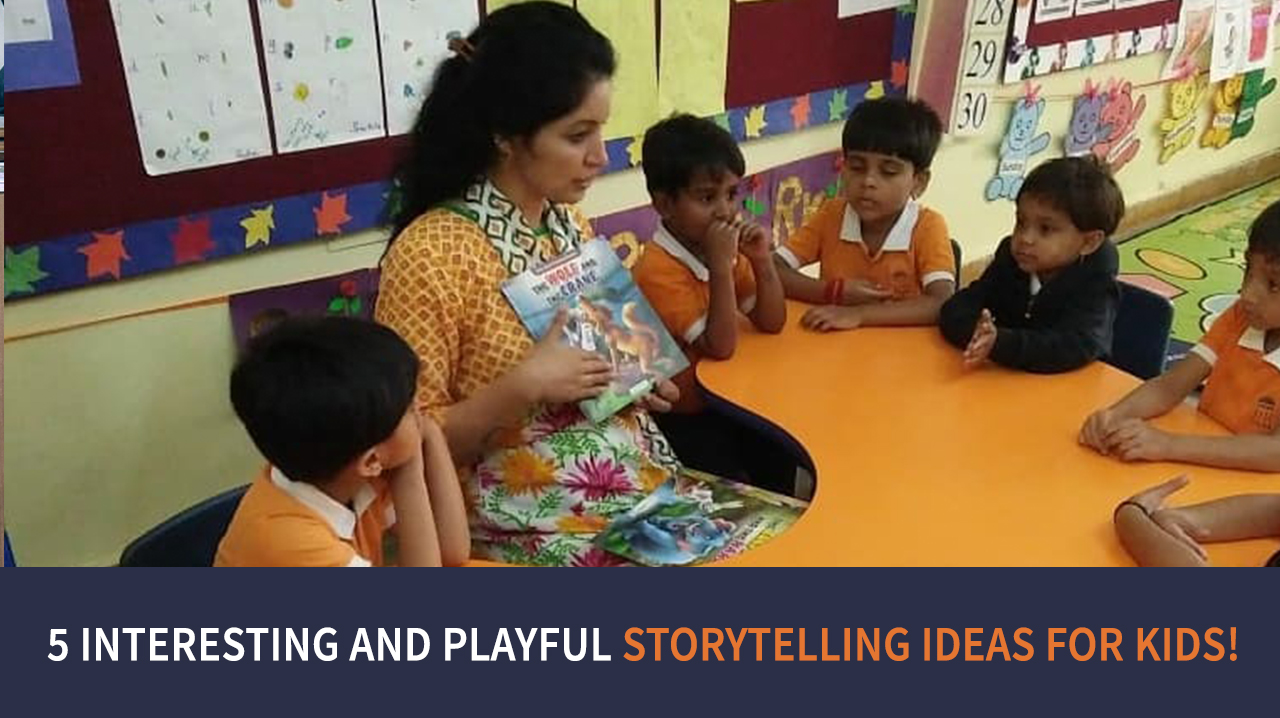5 Interesting and Playful Storytelling Ideas for Kids!

Do you want to help your kids build storytelling skills and engage them in fun activities?
Through our experience with children at MIT Gurukul, the best preschool in Pune, we’ve found that storytelling is an important and effective educational tool as it improves
- communication skills
- creative expression
- eagerness to learn
- literary interest
- confidence
- better concentration
If you want your child to develop these skills and grow an avid interest in storytelling, you’re at the right place! Here are 5 interesting and playful storytelling ideas for kids that will come in handy and help you bond with your child over a meaningful and fun-filled creative pursuit:
1. Dig out some old photos
The things you will need for this activity are:
- Photos
- Glue stick
- Pencil
- Paper sheet
Now, give your children a set of photos and ask them to choose one. Paste that photo on the paper with the glue stick. Ask them to look at the photo for some time and narrate a story about it. You could also write down their words or phrases by paraphrasing with accurate grammar and neat handwriting. After this, reading out the story with voice modulations and some interesting expressions will enhance your child’s oratory and expressive quotient too.
Also Read
2. Sit and draw
Many schools like MIT Gurukul, which follow the IB PYP syllabus, put a great emphasis on extracurricular activities like drawing. You can also do this at home by asking children to draw a picture and colour it. Give them topics to draw that excites them, for example:
- cats and dogs
- a colourful house
- a food item or picnic basket
Asking them to explain what is happening in the picture that they have drawn will boost their imagination. Point towards the objects and let your kids describe them. This may help children to build an interesting story and make connections between the characters they have drawn.
3. One story line at a time
The IB Primary Years Programme for children at institutions like MIT Gurukul, a preschool in Baner, is aimed at making the learning experience more interactive. We host regular storytelling sessions that involve children in listening and speaking activities.
At home, you can also teach storytelling in an interactive way by sitting with your children and starting the story with a sentence. The children can then be asked to add the next line, and so on, and a wonderful story will be built.
Also Read
4. Retell a story
If your kids are not yet at a stage to draw or build a fresh story, you may try reading a story from your child’s favourite storybook to ease them into story appreciation, making sure they’ve understood it and then asking them to retell that story.
You may help them whenever they get stuck by giving them interesting or funny clues. This improves their ability to:
- narrate stories
- memorize events
- listen and read attentively
5. Use fun storytelling props
Looking around the house, you may discover objects your kids love and use them as properties for a storytelling session. This may include items such as:
- soft toys
- dollhouses
- memorable gifts
- chocolate wrappers
- flower plants
- tiffin boxes
Placing these items on a flat surface and letting your kids choose 3 or 4 items with which they would like to build a story gives them a sense of ownership. Paraphrase what they come up with and then read it out to them, through which they will enhance their vocabulary and appreciate language as they grow.
At MIT Gurukul, a top preschool in Pune, we develop new methods every day to stimulate the imagination of kids. Sometimes, your little one may get overwhelmed with formal learning of letters and words, which may feel like a repetitive and tiring chore to their brain. This is exactly when you need to give them a break and apply these interesting storytelling ideas. These storytelling methods will foster your children’s imagination, refresh their minds, build language proficiency and, at the same time, help in your children’s overall development. Click here to explore more about our different teaching methods and techniques.


